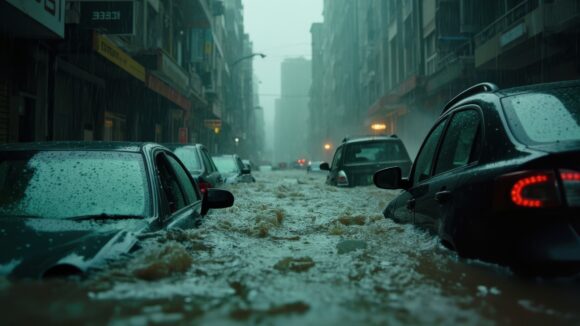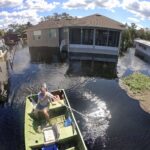Two recent reports–one reviewing property and business interruption risks and the other, liability–highlight a growing divide between escalating risk and shrinking insurance coverage. They also suggest decision-makers need more insight into the risks they face.
A written report from FM, titled “Ready for the Storm: Closing the Extreme Weather Resilience Gap,” and a webinar report from Zywave, “A Look Behind the Headlines: Casualty Market Insights,” both offer data points showing that businesses are buying less insurance to cover growing risks, with costs being a major factor. And both suggest that while risk decision-makers are aware of escalating risks, they may be seriously underestimating the degree of risk specific to their businesses or the regions in which they operate.
Jim Blinn, principal account executive for Zywave, presented a series of graphs displaying escalating excess liability insurance rates per million (per million dollars of program limit), ever-increasing loss severities, and declining limits purchased for casualty insurance in recent years. He called out the limits picture as a “concerning trend.”
“It raises the possibility that organizations are making ill-informed decisions relative to the limits they are purchasing,” Blinn said, before he and co-presenter Senior Account Executive Lauren Boehm highlighted the value to insurance buyers of reviewing litigation outcomes specific to their business types with Zywave models to better inform their limits purchases.
The mutual insurer, FM, didn’t directly list buying more insurance among recommendations in its property-based report. But like Zywave, FM offered recommendations grounded in the insurer’s expertise–delivering long-term risk and resilience insights–when considering strategies to deal with rapidly evolving extreme weather risk hitting their businesses directly or indirectly impacting them through events at supplier locations.
“Minimizing your insurance coverage to cut costs is a false economy. Instead, taking informed, concrete action to boost resilience–throughout the lifecycle of an asset–can not only minimize the risk but keep insurance markets open and affordable,” according to a concluding page in the FM report summarizing recommendations.
Coverage Gaps Quantified
“Insurance is, of course, a vital tool in mitigating the potential financial impact of extreme weather events.” But respondents to an FM survey reported that “their current insurance policy covers less than half of the potential cost of extreme weather’s various effects,” the FM report says, summarizing one of the key results of a survey of 800 risk decision-makers.
Asked about insurance coverage for 11 specific weather-related risks, these risk decision-makers–half from the C-suite and half from risk management in industrial, manufacturing, and technology businesses around the world with revenue ranging from $250 million to more than $10 billion–indicated that property damage was the only weather-related risk that was more than half covered. And that risk was only 53% covered.
On top of page 21 we show the responses for five of the 11 categories of extreme weather events for which respondents said that likely event loss costs could be 8% or 9% of their annual revenue but that insurance covered 46%-53% of those costs.
Brokers were more pessimistic. FM surveyed 150 insurance brokers who estimated, on average, their clients’ insurance would cover around 40% of the losses experienced due to an extreme weather event.
In an earlier section of the report, broker survey results also suggested that risk decision-makers aren’t fully aware of their risks. Only about two-thirds (67%) of brokers surveyed believe their clients are “mostly” or “fully” aware of how exposed their operations are to extreme weather. That compares to 95% of CEOs and risk managers surveyed.
But in this section of the report, FM pointed to the cost of insurance, rather than awareness, as the main issue fueling a coverage gap.
Forty-four percent of the buyers surveyed reported that the cost of insurance is too high to secure full coverage–representing the largest share of responses among the risk decision-makers. Similarly, the largest share of brokers surveyed–49%–said cost was the key reason full coverage hasn’t been purchased.
The report noted some opposing factors fueling the problem: a frequency of catastrophic weather events that has forced insurers to increase rates, and rising inflation overall that has put buyers under pressure to focus on short-term cost reduction.
“When insurance rates are going up, risk managers face the question: ‘Why are we spending so much on insurance?'” said Adriano Lanzilotto, VP, client and partner learning at FM.
The report also indicated that one-third of risk decision-makers ranked limited availability of insurance among their top three challenges in mitigating the risks of extreme weather events.
At the Zywave event, Blinn said he didn’t think availability problems explained the declining limits trends for the sizes of companies his firm studied.
“The limits that we’re seeing that organizations of this size are buying [are] not that huge. And so I think there is availability but not necessarily a desire to purchase it at these [levels] of pricing,” he said, referring to an example that he and Boehm repeated throughout the event: construction companies with between $25 million and $100 million in revenue.
Instead of surveying buyers, Blinn used commercial policy data from Zywave’s benchmarking data to compare trends in limits purchased for these construction companies with prices of insurance coverage.
Noting at one point that the typical retention for the casualty insurance programs is $1 million, Blinn specifically showed that average casualty umbrella limits per $100 revenue fell about 25% between 2018 and 2025, while the average rate per million dollars of program limit more than doubled.
Does this limits reduction make sense when considered against casualty loss trends?
While social inflation and litigation are hot topics, an analysis based on loss data from Zywave’s Excess Casualty Loss Insight Data revealed some eye-opening pops in loss severity.
On page 22, we have captured some of the median, 75th percentile, and 90th percentile loss amounts Blinn displayed for casualty cases in the data base (general liability and auto liability for all types of companies, not just for construction companies, by case disposition year for the last decade).
The graphs reveal that the median casualty loss amount in excess of $1 million jumped more than 70% to over $5 million in the past decade, while the 75th and 90th percentile figures nearly doubled and tripled–to more than $13.5 million and more than $46 million, respectively.
“That hook upward is what insurance companies are dealing with as they think about their pricing,” Blinn said. “This is part of the reason that this median pricing has gone up,” he stated.
Increasing Risk Awareness
Moving from the representations of all the casualty claims to a specific example corresponding more closely to the example that Blinn referred to in the limits discussion, Boehm zeroed in on some loss and limits benchmarking data for construction companies. Imagining a construction firm looking to renew its casualty program with $10 million of umbrella limit ($1 million retention) and facing a 20% price hike, she was able to show that that limit was right in the middle of its peers in a benchmarking analysis.
Going further, she showed details of losses experienced by similar firms that would have exceeded lower selected limits.
Blinn later illustrated the variations in average loss amounts in excess of $1 million for different industries, different firm sizes, and different jurisdictions where cases are brought.
Separately, Swiss Re recently reported that injury type mattered more than company type or company size as a determinant of jury verdict amounts in liability cases.
Back in the property world, FM’s report suggests that risk decision-makers need to get a better handle on the weather risks they face, too. “While most businesses are confident they understand the nature of the risk, FM’s research shows they may not have the full picture,” wrote Dr. Louis Gritzo, staff senior vice president, chief science officer, FM, in a foreward to the report.
An analysis in the report showed a particular lack of extreme weather risk awareness by location. FM specifically asked risk decision-makers to consider the country or region in which their most critical businesses are based and to estimate how much of the economic activity in that area is exposed to wind or flood. The insurer then compared these estimates with FM’s Resilience Index, a ranking of 130 countries and territories’ resilience to risk, which includes a measure of their wind and flood exposure. The comparison revealed that 74% of risk decision-makers underestimate the exposure when compared to calculations in the FM Resilience Index.
Estimates varied significantly by country and region, but businesses with operations in North India, parts of China, and the UK substantially underestimate the wind and flood exposures of these areas. For example, while the FM Resilience Index indicates that 82% of Northern India is exposed, risk officers estimated a 14% exposure–a gap of 68%.
There were gaps of 20% or more in half of the 17 regions the FM analysis asked about. Risk decision-makers were better able to estimate exposure in North America, actually overestimating their exposure in the Midwest vs. the FM Resilience Index.
“Awareness is all about education, and it is incumbent upon insurers like FM to use all our expertise and insight to provide that to corporates and their brokers,” said Benedict McKenna, division claims manager for the UK and Asia Pacific at FM.
This is why FM invests significantly into exploring the science of changing weather patterns. But tracking the weather alone won’t provide a complete picture of a business’s risk exposure, the report stresses, noting that the impact of extreme weather on a given site is specific to its individual characteristics and that the evolution of business practices and building design is changing the nature and severity of risks.
“You may have two facilities located two miles away, and exposures may be very different,” said Stuart Keller, chief engineer of FM in the report. “That’s why site-level assessment is really critical.”
‘A Better Way’
Beyond the survey results, the FM report focuses on a message on the benefits of investing in resilience measures–ranging from embedding risk engineering into the design and construction of new sites to conducting regular site inspection of existing sites to extreme weather.
Businesses’ focus on the cost of insurance may explain “why many powerful measures to mitigate extreme weather risk are under-adopted… Ultimately, though, this short-term view is leaving businesses exposed,” the report says.
“A better way is possible,” the FM report stresses. “Investing in resilience against extreme weather creates a virtuous circle, in which insurance savings can be reinvested in further risk mitigation measures. While there may be extra upfront costs, a more strategic approach to resilience can make a real difference to the cost–and availability–of insurance.”
FM noted that optimizing insurance spending by investing in resilience “requires a collaborative relationship with insurers.” But using the words of one interviewee for this report, some buyers view their insurers as risk “police” and try to keep interaction to a minimum.
“It’s difficult for some clients to move from viewing insurance as occupying a risk oversight role to one of mutual loss prevention,” Dr. Gritzo said. “That is our challenge as an industry: to partner with clients and move from transactional oversight to working together to mitigate the risks.”
He suggested that FM’s mutual model is conducive to a more collaborative relationship, noting that FM issued nearly $1.5 billion in membership and resilience credits to our clients in 2024 to improve their resilience.
This story was originally published in Carrier Management.
Was this article valuable?
Here are more articles you may enjoy.



 Hyundai, Kia Agree to Retrofit 7 Million Vehicles to Address Theft Concerns
Hyundai, Kia Agree to Retrofit 7 Million Vehicles to Address Theft Concerns  State Insurance Legislators ‘Greatly Disturbed’ by Trump AI Regulation Order
State Insurance Legislators ‘Greatly Disturbed’ by Trump AI Regulation Order  Insurance Covers Settlement Paid by Stocks Instead of Money: Delaware High Court
Insurance Covers Settlement Paid by Stocks Instead of Money: Delaware High Court  US House Bill Aims to End Private Flood Insurance Coverage Penalty
US House Bill Aims to End Private Flood Insurance Coverage Penalty 



